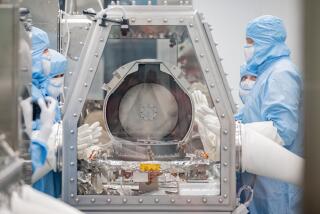A ‘stellar fossil’ holds hints of one of the universe’s first stars
Astronomers say they’ve discovered the signature of one of the first stars in the universe whose remains were embedded into the body of another very old star.
The discovery, described in the journal Science, sheds light on an ancient type of star that existed during the dark ages of the cosmos.
The stars of eons past were not like those of today. Modern-day models like our sun are called population I stars: They’re rich in heavier elements like carbon, oxygen and iron (though “rich” is a relative term – it’s a tiny fraction of the mostly hydrogen-helium body).
A much older generation of star, called population II stars, are very metal-poor (“metals” meaning any elements much heavier than hydrogen and helium).
The oldest, earliest stars are called population III – and they should theoretically be pure hydrogen and helium with virtually no heavy elements.
This stellar taxonomy makes sense – but the problem is, those early population III stars have never been directly spotted.
These first stars should have started forming about 100 million to 250 million years after the Big Bang, when the universe was filled with a soup of hydrogen and helium. And as these ancient stars condensed out of that soup, pulled pockets of mass together and radiated energy into the cosmos, they helped make the universe an increasingly complex place.
When these balls of burning gas died their violent deaths, the heavier elements forged in their nuclear hearts seeded the future generations of stars we see today.
But exactly how all of that happened remains something of a mystery, because scientists know so little about the physical profile of those population III stars, said Volker Bromm of the University of Texas in Austin, who was not involved in the paper.
“The nature of this transition crucially depends on the mass of the first stars,” Bromm wrote in a commentary. And there’s been some debate as to whether these first stars – which grew big quickly and burned out fast – were big, or very big.
“Theoretical models have predicted that the first stars were very massive, possibly a few hundred solar masses,” he wrote. “This prediction, however, has proven to be out of reach for direct empirical testing.”
For one thing, there don’t seem to be any surviving population III stars in the Milky Way. Some astronomers have tried to look for the supernova remnants they left behind, finding a few hints in other galaxies. But for this paper, a team of Japanese and American scientists tried another tactic known as “stellar archeology.” Instead of looking directly for the supernova remains, they looked at more recent (but still very old) stars that had absorbed those remains. Such stars could potentially bear the “fossil” imprint of a long-dead population III star.
The researchers found a star called SDSS J0018-0939 (which, believe it or not, is actually the shortened version of the name). This older-generation star was full of chemical contradictions. For example, it was running unusually low on lighter heavy elements, like carbon and magnesium, but it was also low in cobalt, which doesn’t make sense. A low-carbon signature should mean that the star’s carbon came from a high-energy supernova, while the low-cobalt signature usually implies a “lower explosion energy,” the study authors wrote.
These contradictions could be explained if an older, population III star had undergone a rare, dramatic explosion: a pair-instability supernova.
For most of its life, a star is held in balance by two main forces – the energetic photons of light that push out, and the gravity of its massive body that pulls it in. In this particular stellar death, the star’s photons become so energetic that they end up as electron-positron pairs. Unlike the original photons, these pairs don’t do much to hold the star up against its own crushing gravity, and it soon collapses. But all that material rushing inward causes the internal temperature to shoot up and the core to burn through the rest of its nuclear fuel, setting off what Bromm called “a colossal thermonuclear explosion.”
To have left such a mark, the star must have been very big – according to theory, more than 140 times as massive as our sun. And while such massive stars probably would have been rare among the ancient, population III stars, the fact that they did exist “is of great importance,” Bromm wrote.
For one thing, he pointed out, “such energetic supernovae can greatly influence the early universe.” For another, knowing how big this star type can get gives physicists insight into how these stellar behemoths form.
Another bright side (literally): These PISNs are so luminous that NASA’s James Webb Space Telescope, slated for launch in 2018, could perhaps, for the first time, directly pick out the supernova remains of an elusive population III star.
Love astronomy? Follow @aminawrite for more science news that’s out of this world.







